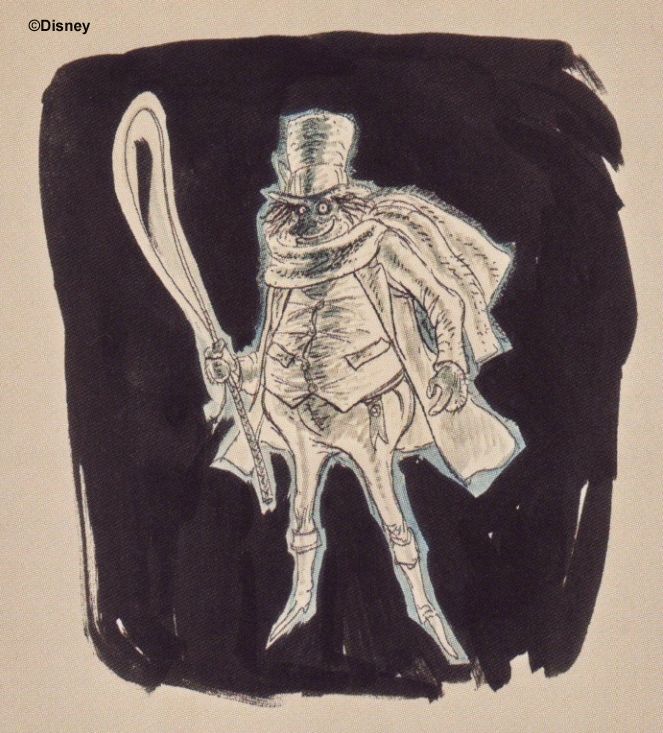Updated October 2019
Let's continue with our probes into the cultural background of the various ghosts and ghoulies populating the Mansion. Some are mere visual puns and have a thin background (Great Caesar's Ghost, the Phantoms of the Opera), others can be traced back to a single famous ghost (The Brown Lady of Raynham Hall, the Phantom Drummer of Tedworth), and some take their cue from a more general historic or folkloric setting (the Victorian "mummy craze," the numerous legends about ghostly hitchhikers). Sometimes "mere folklore" veers over into full-blown myth, carrying an almost religious portent. That's where we're headed today, as we turn our gaze toward the Hearse Tea Party in the graveyard. Here it is in magnificent 3D, in two sizes, and once again, it's worth it to do the "magic eye" thing, as the depth of field in this one is particularly enjoyable.
The man in charge here seems to be the coachman.
All you have to do is Google "phantom coachman" or "death coach" or the like, and you'll summon up tons of folklore. This is a major ghost. He's a fully mythological figure in Irish folklore, the Dullahan, driving the Cóiste Bodhar ("coach-a-bower"). The Dullahan is a headless coachman who works in coordination with the Banshee and takes you away when you're about to die. Interestingly, it is widely agreed that the most satisfying treatment of this figure in modern pop culture is in the 1959 Disney film, Darby O'Gill and the Little People. (Mansionites particularly enjoy the Banshee in this film because a couple of its wails were either added to or taken from the Disney sound library and emigrated from there into the Haunted Mansion's Corridor of Doors.)
Here he comes...
Get in.
Another interesting cinematic treatment of the Death Coach is in F.W. Murnau's classic, Nosferatu (1922). En route to the castle Dracula, Jonathan Harker is whipped across Transylvanian no-man's land in a phantom coach. This suggests that poor Jonny is in some sense leaving the land of the living and passing over into the land of the dead.
Check HERE for another 1921 treatment of the Death Coach, this time in a Swedish film.
Plenty of "real" phantom coaches have been reported. Part of the ghostly doings at Borley Rectory ("The Most Haunted House in England") involve unseen coaches and thundering hoofbeats passing by, or glimpses of a ghostly coach with a headless driver. The Edinburgh Royal Mile has its very own phantom coach, they say.
The phantom's appearance varies. Besides the headless coachman, there's a monstrous one, a Grim Reaper-like skeletal one, and a fairly "normal" looking one. Asked to create a Phantom Coachman mask/wall sculpture, the folks at Dynamic Design International (who have done some work for Disney) came up with this as the classic look:
Likewise, the vehicle varies. Usually it's a proper black stagecoach, but often in popular depiction it's a hearse.
Was any of this in the background as Marc Davis designed his tea party ensemble? Alas, the paper trail is much thinner this time. His concept sketch looks pretty much like what we ended up getting.
This Davis sketch of a "Phantom Coachman" was not published until 2019.
MDIHOW 407
However, there are depictions of the Death Coach in pop iconography that are remarkably similar to Davis's graveyard hearse in appearance. This is from a 1954 comic book:If you have your parents' permission, you can read the rest HERE, but be forewarned: that stuff will rot your brain. Anyway, this is all fair game, as we have already seen that Davis was not above taking inspiration from horror comics.
Davis's driver is a lot less gruesome, but he is, literally, a phantom coachman, and he's presumably the one who brought these folks to the graveyard (i.e., the place of the dead). The similar hearse dropping off guestly ghosts in the ballroom originally was going to have a friendly driver too, to judge from Davis's concept art.
Essentially, what we've got is a cheerful Charon. That's definitely how Collin Campbell read Davis's graveyard drawing when he did the cover of the "Story and Song" album. (You'll note that Collins combines elements from both of the Davis concept pieces above.) The phantom is providing a taxi service in this painting that is not essentially dissimilar to his function in the scarier treatments.
Davis obviously wanted to get away from the scary phantom coachman and make him a light, comic figure. Indeed, the Davis/Collins coachman looks like a cross between Mr. Magoo and W. C. Fields. Other Disney artists have also treated this character and this topic. One interesting example is on the back cover of the 1970 Magic from the Haunted Mansion souvenir book. That artist clearly interpreted the graveyard hearse as the Death Coach:
When Imagineers in the 90's kicked around ideas for improving the Load area, one of the new concepts called for a full-blown Death Coach in a large window. Notice that once again it's a hearse, not a stagecoach, but this time the Grim Reaper version of the coachman is used:
It's a thinner trail this time, but I'm willing to put down the coachman at the Hearse Tea Party as another spook with solid roots in established ghost lore. It is most curious that we humans are consistently interested not only in the afterlife but in the means of transport from this world into that one. When we're not talking about angelic escort by walking or flying, we're seeing visions of boats and coaches. A carriage approaches, to take you into the boundless realm. Part of the journey is the mode of transportation itself, it seems. And for that last trip, there is no longer any need to pull down on the safety bar.
.






0 Yorumlar